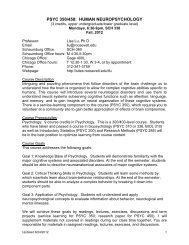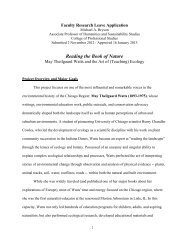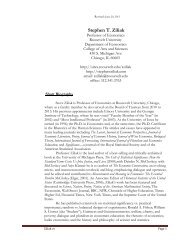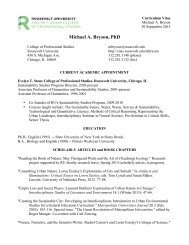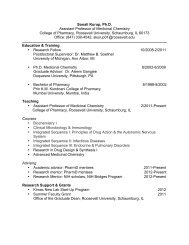Social Insurance and Public Assistance
public-assistance-welfare-reform-colonial-times-to-the-present-ziliak ...
public-assistance-welfare-reform-colonial-times-to-the-present-ziliak ...
You also want an ePaper? Increase the reach of your titles
YUMPU automatically turns print PDFs into web optimized ePapers that Google loves.
PRIVATE WELFARE Series Bf786–801 823<br />
TABLE Bf786–801 Private social welfare expenditures – disaggregations of major categories: 1960–1997 Continued<br />
Sources<br />
For series Bf786–789, see the Health Care Financing Administration Internet<br />
site, National Health Care Expenditures. See also Health Care Financing Review,<br />
Statistical Supplement, 1998.For series Bf790–800, Wilmer Kerns, “Private<br />
<strong>Social</strong> Welfare Expenditures, 1972–94,” <strong>Social</strong> Security Bulletin 60 (1) (1997):<br />
54–9 <strong>and</strong> “Role of the Private Sector in Financing <strong>Social</strong> Welfare Programs,<br />
1972–92,” <strong>Social</strong> Security Bulletin 58 (1) (1995): 66–73. There are some exceptions<br />
for the income-maintenance expenditures: the figures for 1974 <strong>and</strong><br />
1976–1978 are from Wilmer Kerns <strong>and</strong> Milton P. Glanz, “Private <strong>Social</strong> Welfare<br />
Expenditures, 1972–95,” <strong>Social</strong> Security Bulletin 51 (8) (1988): 8; <strong>and</strong> the<br />
figures for 1979 <strong>and</strong> 1984 are from Wilmer Kerns, “Private <strong>Social</strong> Welfare<br />
Expenditures, 1972–92,” <strong>Social</strong> Security Bulletin 57 (3) (1992): 63. For series<br />
Bf801, see Wilmer Kerns, “<strong>Social</strong> Welfare Expenditure, 1972–1991,” <strong>Social</strong><br />
Security Bulletin 57 (1) (1994): 92, <strong>and</strong> Kerns <strong>and</strong> Glanz (1988).<br />
Documentation<br />
For more detail on health care expenditures <strong>and</strong> the source, see the text for<br />
Table Bf875–886.<br />
Series Bf786. Identical to series Bf876, <strong>and</strong> the sum of series Bf787–789.<br />
Series Bf787. Health services <strong>and</strong> supplies include “personal health care,”<br />
comprising therapeutic goods or services rendered to treat or prevent a specific<br />
disease or condition in a specific person, <strong>and</strong> services, including hospital<br />
services, physician services, dental service, durable <strong>and</strong> nondurable medical<br />
devices, nursing home care, program administration, <strong>and</strong> net costs of health<br />
insurance. The series represents spending for care rendered during the year.<br />
It is the sum of personal health care expenditures, government public health<br />
activity, <strong>and</strong> program administration. It is distinguished from research <strong>and</strong><br />
construction expenditures, which represent an investment in the future health<br />
care system.<br />
Series Bf788–789. Includes noncommercial biomedical research <strong>and</strong> the<br />
construction of health care facilities.<br />
Series Bf790. Identical to series Bf775.<br />
Series Bf790–795. In the years 1980 through 1994, the subcategories should<br />
sum to series Bf790. Prior to that time, series Bf790 includes information on<br />
accidental death <strong>and</strong> dismemberment. Missing information on sickness <strong>and</strong><br />
disability in some years (see discussion that follows) also prevent the subcategories<br />
from summing to the total. See the text for Table Bf773–785 for<br />
more detail.<br />
Series Bf791. Includes programs for government civilian employees in order<br />
to maintain consistency with data reported for years prior to 1988. The<br />
estimates are further adjusted to exclude group policies not based directly<br />
on employer–employee relationships, such as insurance for credit card holders,<br />
mortgage insurance, fraternal societies, savings or investment groups,<br />
professional societies <strong>and</strong> employee associations; the excluded categories<br />
account for about 8 percent of total life insurance benefits. The totals also<br />
include accidental death <strong>and</strong> dismemberment benefits for the 1972–1979<br />
period. After 1979, the Health <strong>Insurance</strong> Association of America eliminated<br />
this item from their questionnaire.<br />
Series Bf792. Based on m<strong>and</strong>atory form 5500 reports filed with the Internal<br />
Revenue Service <strong>and</strong> forwarded to the Department of Labor. Definedcontribution<br />
benefit plans included 401(k)-type plans, into which employees<br />
can contribute a portion of their salaries with or without employer contributions<br />
on a tax-deferred basis. Another form of pension coverage is<br />
the employee stock ownership plan. Benefits paid include benefits from all<br />
employment-related pension plans to which employees contribute (such as<br />
thrift plans). However, withdrawals from individual savings plans, individual<br />
retirement accounts, <strong>and</strong> Keogh plans are not included. More detail on<br />
specific types of pension plan expenditures is available in the source.<br />
Series Bf793. Sickness <strong>and</strong> disability benefits are sick leave <strong>and</strong> payments<br />
for short-term sickness <strong>and</strong> disability from private <strong>and</strong> self-insurance. After<br />
1980 long-term <strong>and</strong> short-term disability benefits are estimated separately.<br />
This series does not correspond exactly to the series on short-term sickness<br />
benefits in Tables Bf854–874. For the years 1972–1986, Kerns <strong>and</strong> Glanz<br />
(1988, p. 8) report figures on sickness <strong>and</strong> disability benefits, but the estimates<br />
for the overlapping years do not match up with the data on sickness<br />
<strong>and</strong> disability reported in this table.<br />
Series Bf793 <strong>and</strong> Bf801. In the 1995 Kerns article, there was a change in the<br />
method of calculating sickness <strong>and</strong> disability insurance payments that led to<br />
substantial changes in the numbers reported. Series Bf801 was included for<br />
persons who were interested in having a consistent series for changes during<br />
the 1970s <strong>and</strong> early 1980s. Kerns seems to consider series Bf793 to be the<br />
superior estimate.<br />
Series Bf794. Long-term disability benefits, as a rule, commence on the first<br />
day of the seventh month of disability. The figures are estimated from data<br />
supplied by the Health <strong>Insurance</strong> Association of America. Long-term disability<br />
benefits paid under the provisions of employment-related pension plans<br />
are included in the private pension category.<br />
Series Bf795. Data on supplemental unemployment benefits are taken from<br />
the national income <strong>and</strong> product accounts (NIPA) series on other labor income<br />
by industry <strong>and</strong> by type. Most of these benefits are paid to automobile<br />
workers under management-union contractual agreements.<br />
Series Bf796. Identical to series Bf776, <strong>and</strong> the sum of series Bf797–800.<br />
Series Bf796–800. The education spending figures are derived from methods<br />
developed by both the <strong>Social</strong> Security Administration (SSA) <strong>and</strong> the U.S.<br />
Bureau of Economic Analysis (BEA). For consistency, the SSA is now using<br />
the BEA’s NIPA estimates with two minor adjustments. The SSA estimates<br />
include school construction costs funded by private sources, which the BEA<br />
reports elsewhere. The BEA estimate for education includes contributions<br />
from foundations <strong>and</strong> from nonprofit research funds, which are excluded by<br />
the SSA.<br />
Series Bf801. Covers private industry wage <strong>and</strong> salary workers.



